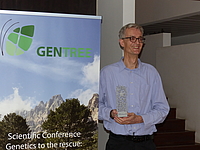A workshop focused on developing a national Strategy for UK Forest Genetic Resources (FGR) was held at the Millennium Seed Bank, Royal Botanic Gardens Kew (UK) on 26th April 2018. The event represents a crucial step in coordination of existing initiatives at national level in UK, in creating synergy with international efforts, and ultimately in securing the conservation of forest genetic resources in the UK.
Set of options for the future
The ability of woods and trees to meet current and future societal and environmental challenges depends on the availability of diversity – at both species and genetic levels. Within species, genetic diversity needs to be maintained to allow them to persist, adapt and evolve under changing environmental conditions and face pressures, such as pests and diseases.
Maintaining genetic diversity also helps to preserve a broad set of options for future tree improvement and breeding, including the possibility to develop traits that are not currently valued but may be important in the future. However, to date, FGR have been neglected in the UK and their value poorly recognized.
Strategic framework
Until recently, there has been little coordinated focus in the UK on genetic diversity in trees as a resource. Where research has taken place, activities have typically been independent single species studies, often at a small-scale, and never within a shared strategic framework.
To address these constraints, a wide range of UK institutions and stakeholders came together and proposed a Strategy for UK Forest Genetic Resources. A steering group, including the Millenium Seed Bank (RBG Kew), the Centre for Ecology and Hydrology, Forest Research, Future Trees Trust and the Woodland Trust drafted the text following input from stakeholders. Scientists from GenTree – Bruno Fady and Stephen Cavers (the latter of whom will serve on the steering group) – contributed their knowledge and experience gathered as part of the project.
The Strategy aims to identify and protect genetic diversity in tree species that is unique to the country, and to promote its sustainable management. The proposed action will focus on native tree species and introduced species in cases where naturalization has taken place or where important varieties or landraces were developed in the UK.
The vision is to promote understanding of the patterns and drivers of genetic diversity and local adaptation in UK trees and to make this knowledge easily understandable and widely available to those in charge of conservation and use of tree resources.
Genetic conservation units
The Strategy has five areas for action: Collaboration for Change; Communication; Research; In situ Conservation; Ex situ Conservation. One of the first activities will be to create a network of in situ genetic conservation units for tree species. The British sampling sites for species in the GenTree project, with the uniquely detailed environmental, phenotypic and genotypic data that will result from project activities, will be the backbone of this network.
The GenTree project will make major advances in understanding local adaptation in its focal species and will help put national actions, such as those proposed by the UK Strategy on FGR, in an international context. Aligning national initiatives with the European Forest Genetic Resources Programme (EUFORGEN) and ensuring conservation units are compatible with the criteria for inclusion in its information system (EUFGIS) helps to integrate knowledge across species as well as evaluate national resources.
Just a few weeks after the workshop, the UK government launched its ‘Tree Health Resilience Strategy’, which gives explicit support for the new UK Strategy for Forest Genetic Resources and delivery of its action plan through existing and new collaborative activities – a good step on the path toward conserving the vital resource of tree genetic diversity.


